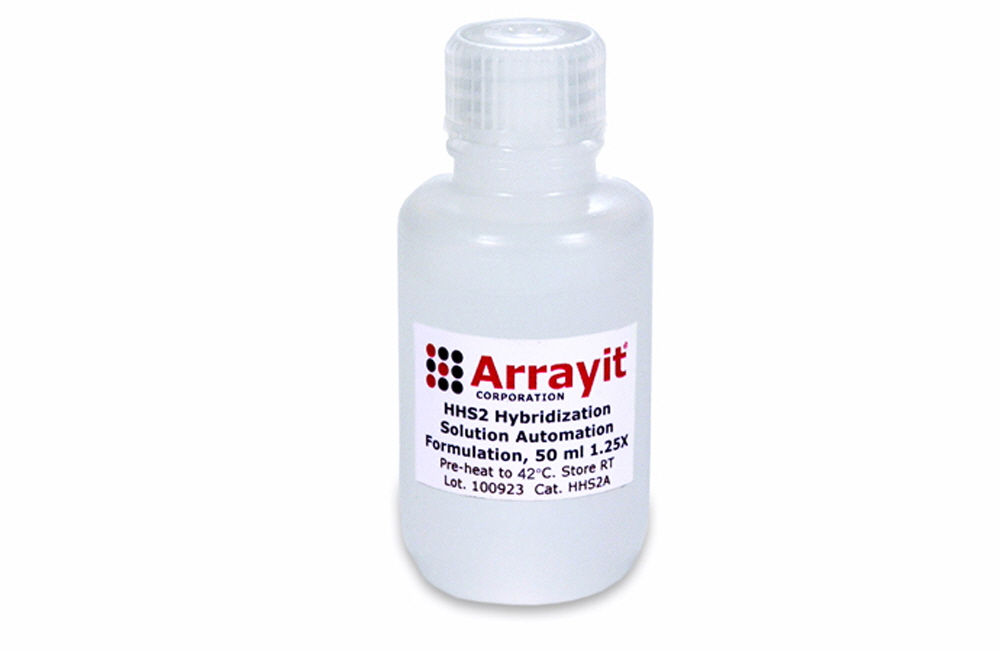HybIt® 2
Data Sheet
![]() Shop this product in our online store
Shop this product in our online store
Products - Buffers & Solutions - Hybridization Solutions - HybIt® 2 Formamide-Based Hybridization Buffer for DNA Microarrays

Arrayit has developed HybIt® 2 Hybridization Solution containing an advanced formamide mixture that improves microarray hybridization reactions by increasing signal intensities and reducing background in reactions with cDNAs and long oligonucleotides. Use HybIt® to produce superior data with microarrays printed on atomically flat Super Microarray Glass Substrate Slides. HybIt® 2 Hybridization Solution Automation Formulation is highly recommended for use with TrayMix™ Hybridization Stations.
Table of Contents
Introduction
Quality Control
Product Description
Technical Assistance
Short Protocol
Complete Protocol
Requirements
Troubleshooting Tips
Ordering Information
Warranty
Introduction
Congratulations on taking a big step towards improving the economies of scale, quality and speed of your genomics research. This booklet contains a complete set of protocols outlining the steps and principles needed to use Arrayit HybIt® 2 Hybridization Solution.
Quality Control
Arrayit assures the performance of this product. The finest scientific research went into the development of this product. Rigorous quality control monitoring on a lot-by-lot basis guarantees that the ingredients conform to the highest industry standards.
Product Description
The Arrayit HybIt® 2 Hybridization Solution is an advanced hybridization solution containing a patent-pending mixture of salts, detergents and buffering components. Use of HybIt® 2 Hybridization Solution will increase the quality of microarray biochip hybridizations reactions involving base pairing interactions between complementary nucleic acid chains. Users will appreciate the following features:
- Increases signal by accelerating hybridization kinetics
- Increases sensitivity by reducing background fluorescence
- Reduces surface tension providing a uniform hybridization layer
- Buffering components stabilize extended reactions
- Compatible with many glass-based surface chemistries
- Arrives pre-mixed and sterile, no preparation required
- Costs <$1 dollar per hybridization reaction
Technical Assistance
Please contact us if you have any comments, suggestions, or if you need technical assistance. By electronic mail: arrayit@arrayit.com (under the subject heading, please type Arrayit technical assistance). Please remember that we want to hear about your successes!
Short Protocol (Steps 1-7)
1. Print microarrays or obtain Arrayit Custom printed microarrays.
2. Process the microarrays for hybridization.
3. Purify probe using ArrayIt Fluorescent Probe Purification Kit.
3. Resuspend fluorescent probe in 1.0 part dH20 and 4.0 parts HybIt® 2 Solution.
3. Hybridize the probe to the microarray under the appropriate conditions.
5. Wash away the unbound fluorescent probe. ArrayIt wash buffers A, B & C are recommended.
6. Scan the microarray for fluorescent signal.
7. Score the hybridization results.
Complete Protocol (Steps 1-7)
1. Print microarrays with an Arrayit Micro Spotting device or a suitable microarray technology. In principle, HybIt® 2 should improve detection on many different microarray platforms.
2. Process the microarrays for hybridization. After the microarrays are spotted, the slides should be allowed to dry at room temperature overnight for arrays printed on SuperAldehyde. This can be accomplished by placing the slides in a slide box with the lid slightly ajar. Drying increases the binding of the amino-modified DNA to the aldehyde surface. After drying, the slides should be processed to remove unbound DNA. Many protocols have been used for slide processing. The hybridization section at http://arrayit.com for more information.. Microarrays printed on SuperAmine should be crosslinked by either baking at 80°C for 80 minutes or by using a UV Crosslinker (120 mJ).
3. Purify the fluorescent probe with the ArrayIt Fluorescent Probe Purification Kit and resuspend in HybIt® 2 Hybridization Solution, which is provided as a 1.25X solution. This is accomplished by first resuspending the probe in 1.0 part dH20, and then adding 4.0 parts of HybIt® 2 Hybridization Solution. Prior to using HybIt® 2 Hybridization Solution, pre-warm the solution for 30 sec at 42°C and mix by inverting the tube several times. A fluorescent probe desiccated to dryness would be re-suspended by adding 2.0 µl of dH20, followed by 8.0 µl of pre-warmed HybIt® 2 Hybridization Solution. Probes should be single-stranded DNA or RNA molecules made by either reverse transcription or in vitro transcription of cRNA.
4. Hybridize the probe to the microarray under the appropriate conditions (42°C). This is accomplished by using 1.25 µl of probe in 1X HybIt® 2 per cm2 glass cover slip. For best results, add the probe to one edge of the cover slip surface, and then gently lower the cover slip onto the microarray with fine forceps allowing the probe to sheet evenly across the surface between the cover slip and the slide. Transfer the substrate with cover slip to a pre-warmed Arrayit Hybridization Cassette containing 10.0-µl warmed dH20 in each well. Also use 10-20 ul of warmed dH20 under the substrate. Seal the cassette and hybridize for overnight at 42°C.
5. Wash away the unbound fluorescent probe. Remove the microarray from the Hybridization Cassette and immediately transfer the slide to an Arrayit Wash Station and wash according to directions.
6. Scan the microarray for fluorescent signals. Insert the substrate into the ScanArray 3000 (Packard Bio Science) or a compatible detection system and scan the area of the slide containing the microarray. The scan area, excitation source, laser power and PMT settings can all be adjusted with the ScanArray software. Laser and PMT settings should be chosen to give maximal unsaturated signal with minimal background fluorescence. Typically, laser and PMT settings of 70% and 60-80% respectively yield good results with the ScanArray 3000.
7. Score the hybridization results. Upload the scanned image tiff file into the ImaGene software (BioDiscovery) or a suitable quantitation package and examine each feature for fluorescence intensity.
Requirements
Micro Spotting Device
High Throughput Wash Station
Fluorescent Probe Purification Kit
Micro-Spotting Solution Plus
Hybridization Cassettes
Super Microarray Substrates
Troubleshooting Tips
High Background:
Impure cDNAs or oligonucleotides used for spotting.
Used conventional buffers instead of HybIt 2 Hybridization Solution.
Incorrect hybridization temperature.
Unincorporated fluors were not sufficiently purified away from probe, use Fluorescent Probe Purification Kit.

